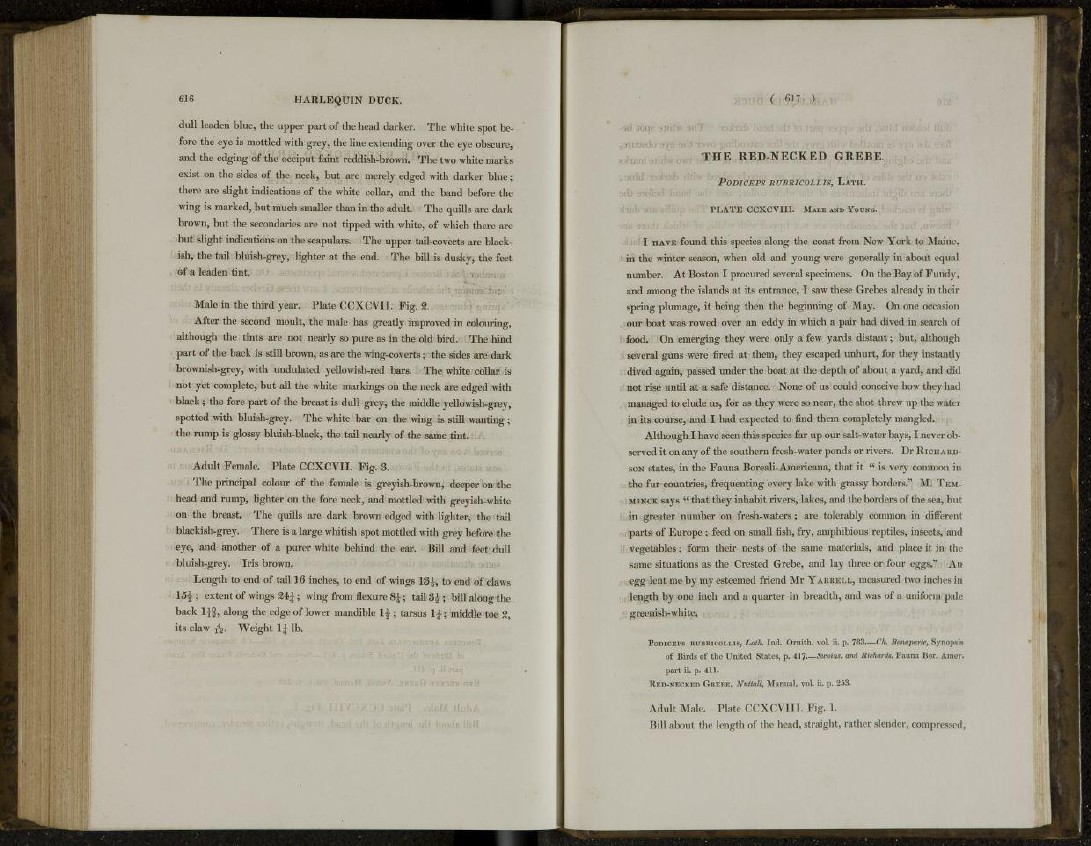
616 HARLEQUIN DUCK.
dull leaden blue, the upper part of the head darker. The white spot before
the eye is mottled with grey, the line extending over the eye obscure,
and the edging of the occiput faint reddish-brown. The two white marks
exist on the sides of the neck, but are merely edged with darker blue;
there are slight indications of the white collar, and the band before the
wing is marked, but much smaller than in the adult. The quills are dark
brown, but the secondaries are not tipped with white, of which there are
but slight indications on the scapulars. The upper tail-coverts are blackish,
the tail bluish-grey, lighter at the end. The bill is dusky, the feet
of a leaden tint.
Male in the third year. Plate CCXCVII. Fig. 2.
After the second moult, the male has greatly improved in colouring,
although the tints are not nearly so pure as in the old bird. The hind
part of the back is still brown, as are the wing-coverts; the sides are dark
brownish-grey, with undulated yellowish-red bars. The white collar is
not yet complete, but all the white markings on the neck are edged with
black ; the fore part of the breast is dull grey, the middle yellowish-grey,
spotted with bluish-grey. The white bar on the wing is still wanting ;
the rump is glossy bluish-black, the tail nearly of the same tint.
Adult Female. Plate CCXCVII. Fig. 3.
The principal colour of the female is greyish-brown, deeper on the
head and rump, lighter on the fore neck, and mottled with greyish-white
on the breast. The quills are dark brown edged with lighter, the tail
blackish-grey. There is a large whitish spot mottled with grey before the
eye, and another of a purer white behind the ear. Bill and feet dull
bluish-grey. Iris brown.
Length to end of tail 16 inches, to end of wings 18£, to end of claws
15^ ; extent of wings 24£; wing from flexure 8 1 ; tail 3^ ; bill along the
back 11§, along the edge of lower mandible 1^ ; tarsus 1£; middle toe 2,
its claw TV Weight 1£ lb.
( 617 )
THE RED-NECKED GREBE.
PODICEPS RUBRICOLLIS, LATH.
PLATE CCXCVIII. MALE AND YOUNG.
I HAVE found this species along the coast from New York to Maine,
in the winter season, when old and young were generally in about equal
number. At Boston I procured several specimens. On the Bay of Fund v,
and among the islands at its entrance, I saw these Grebes already in their
spring plumage, it being then the beginning of May. On one occasion
our boat was rowed over an eddy in which a pair had dived in search of
food. On emerging they were only a few yards distant; but, although
several guns were fired at them, they escaped unhurt, for they instantly
dived again, passed under the boat at the depth of about a yard, and did
not rise until at a safe distance. None of us could conceive how they had
managed to elude us, for as they were so near, the shot threw up the water
in its course, and I had expected to find them completely mangled.
Although I have seen this species far up our salt-water bays, I never observed
it on any of the southern fresh-water ponds or rivers. Dr RICH A BDSON
states, in the Fauna Boreah-Americana, that it " is very common in
the fur countries, frequenting every lake with grassy borders.11 M. TEMMINCK
says " that they inhabit rivers, lakes, and the borders of the sea, but
in greater number on fresh-waters; are tolerably common in different
parts of Europe ; feed on small fish, fry, amphibious reptiles, insects, and
vegetables; form their nests of the same materials, and place it in the
same situations as the Crested Grebe, and lay three or four eggs.11 An
egg lent me by my esteemed friend Mr YARRELL, measured two inches in
length by one inch and a quarter in breadth, and was of a uniform pale
greenish-white.
PODICEPS RUBRICOLLIS, Lath. Ind. Ornith. vol. ii. p. 783.—Ch. Bonaparte, Synopsis
of Birds of the United States, p. 417.—Swains, ami Richards. Fauna Bor. Amer.
part ii. p. 411.
RED-NECKED GREBE, Nuttall, Manual, vol. ii. p. 253.
Adult Male. Plate CCXCVIII. Fig. 1.
Bill about the length of the head, straight, rather slender, compressed,